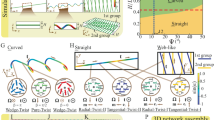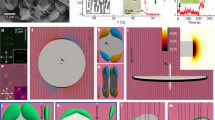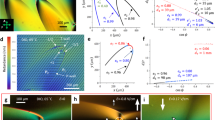Abstract
Orientational ordering is key to functional materials with switching capability, such as nematic liquid crystals and ferromagnetic and ferroelectric materials. We explored the confinement of nematic liquid crystals in bicontinuous porous structures with smooth surfaces that locally impose normal orientational order on the liquid crystal. We find that frustration leads to a high density of topological defect lines permeating the porous structures, and that most defect lines are made stable by looping around solid portions of the confining material. Because many defect trajectories are possible, these systems are highly metastable and efficient in memorizing the alignment forced by external fields. Such memory effects have their origin in the topology of the confining surface and are maximized in a simple periodic bicontinuous cubic structure. We also show that nematic liquid crystals in random porous networks exhibit a disorder-induced slowing-down typical of glasses that originates from activated collisions and rearrangements of defect lines. Our findings offer the possibility to functionalize orientationally ordered materials through topological confinement.
This is a preview of subscription content, access via your institution
Access options
Subscribe to this journal
Receive 12 print issues and online access
$259.00 per year
only $21.58 per issue
Buy this article
- Purchase on Springer Link
- Instant access to full article PDF
Prices may be subject to local taxes which are calculated during checkout






Similar content being viewed by others
References
Kleman, M. & Lavrentovich, O. D. Soft Matter Physics: An Introduction (Springer, 2003).
Crawford, G. P. & Žumer, S. (eds) Liquid Crystals in Complex Geometries Formed by Polymer and Porous Networks (Taylor and Francis, 1996).
Kim, J-H., Yoneya, M. & Yokoyama, H. Tristable nematic liquid-crystal device using micropatterned surface alignment. Nature 420, 159–162 (2002).
Golemme, A., Žumer, S., Allender, D. A. & Doane, J. W. Continuous nematic–isotropic transition in submicron-size liquid-crystal droplets. Phys. Rev. Lett. 61, 2937–2940 (1988).
Terentjev, E. M. Disclination loops, standing alone and around solid particles, in nematic liquid-crystals. Phys. Rev. E 51, 1330–1337 (1995).
Poulin, P., Stark, H., Lubensky, T. C. & Weitz, D. A. Novel colloidal interactions in anisotropic fluids. Science 275, 1770–1773 (1997).
Stark, H. Physics of colloidal dispersions in nematic liquid crystals. Phys. Rep. 351, 387–474 (2001).
Bradač, Z., Kralj, S. & Žumer, S. Molecular dynamics study of nematic structures confined to a cylindrical cavity. Phys. Rev. E 58, 7447–7454 (1998).
Araki, T. & Tanaka, H. Colloidal aggregation in a nematic liquid crystal: Topological arrest of particles by a single stroke disclination line. Phys. Rev. Lett. 97, 127801 (2006).
Wu, X., Goldburg, W. I., Liu, M. X. & Xue, J. Z. Slow dynamics of isotropic–nematic phase transition in silica gels. Phys. Rev. Lett. 69, 470–473 (1992).
Bellini, T. et al. Phase behavior of the liquid crystal 8CB in a silica aerogel. Phys. Rev. Lett. 69, 788–791 (1992).
Iannacchione, G. S., Crawford, G. P., Žumer, S., Doane, J. W. & Finotello, D. Randomly constrained orientational order in porous glass. Phys. Rev. Lett. 71, 2595–2598 (1993).
Bellini, T. et al. Nematics with quenched disorder: How long will it take to heal? Phys. Rev. Lett. 88, 245506 (2002).
Buscaglia, M. et al. Memory effects in nematics with quenched disorder. Phys. Rev. E 74, 011706 (2006).
Kang, D., Maclennan, J. E., Clark, N. A., Zakhidov, A. A. & Baughman, R. H. Electro-optic behavior of liquid-crystal-filled silica opal photonic crystals: Effect of liquid-crystal alignment. Phys. Rev. Lett. 86, 4052–4055 (2001).
Radzihovsky, L. & Toner, J. Smectic liquid crystals in random environments. Phys. Rev. B 60, 206–257 (1999).
Feldman, D. E. Quasi-long-range order in nematics confined in random porous media. Phys. Rev. Lett. 84, 4886–4889 (2000).
Rutunno, M. et al. Nematics with quenched disorder: Pinning out the origin of memory. Phys. Rev. Lett. 94, 097802 (2005).
Lammert, P. E., Rokhsar, D. S. & Toner, J. Topology and nematic ordering. I. A Gauge theory. Phys. Rev. E 52, 1778–1800 (1995).
Cang, H., Novikov, V. N. & Fayer, M. D. Experimental observation of a nearly logarithmic decay of orientational correlation function in supercooled liquids on the picosecond-to-nanosecond time scales. Phys. Rev. Lett. 90, 197401 (2003).
Götze, W. & Sperl, M. Nearly logarithmic decay of correlations in glass-forming liquids. Phys. Rev. Lett. 92, 105701 (2004).
Yin, Y., Shiyanovskii, S. V., Golovin, A. B. & Lavrentovich, O. D. Dielectric torque and orientation dynamics of liquid crystals with dielectric dispersion. Phys. Rev. Lett. 95, 087801 (2005).
Mühlbauer, S. et al. Skyrmion lattice in a chiral magnet. Science 323, 915–919 (2009).
Doria, M. M., Romaguera, A. R. de C., Milosevic, M. V. & Peeters, F. M. Threefold onset of vortex loops in superconductors with a magnetic core. Europhys. Lett. 79, 47006 (2007).
Lebwohl, P. A. & Lasher, G. Nematic-liquid-crystal order—Monte Carlo calculation. Phys. Rev. A 6, 426–429 (1972).
Fabbri, U. & Zannoni, C. A Monte Carlo investigation of the Lebwohl–Lasher lattice model in the vicinity of its orientational phase transition. Mol. Phys. 58, 763–788 (1986).
de Gennes, P. G. & Prost, J. The Physics of Liquid Crystals 2nd edn (Oxford Univ. Press, 1993).
Binder, K. & Kob, W. Glassy Materials and Disordered Solids (World Scientific Pub., 2005).
Ogielski, A. T. Dynamics of three-dimensional Ising spin-glasses in thermal equilibrium. Phys. Rev. B 32, 7384–7398 (1985).
Onuki, A. Phase Transition Dynamics (Cambridge Unv. Press, 2002).
Acknowledgements
We thank C. P. Royall for a critical reading of the manuscript. This work was supported by a Grant in Aid from the Ministry of Education, Culture, Sports, Science, and Technology, Japan, and by the Cariplo Foundation (grant 2008-2413), Italy.
Author information
Authors and Affiliations
Contributions
T.B. and H.T. conceived the project, T.A. carried out numerical simulations, M.B. carried out experiments and all authors analysed the data and wrote the manuscript.
Corresponding authors
Ethics declarations
Competing interests
The authors declare no competing financial interests.
Supplementary information
Supplementary Information
Supplementary Information (PDF 1776 kb)
Supplementary Movie
Supplementary Movie (MOV 2348 kb)
Supplementary Movie
Supplementary Movie (MOV 1195 kb)
Rights and permissions
About this article
Cite this article
Araki, T., Buscaglia, M., Bellini, T. et al. Memory and topological frustration in nematic liquid crystals confined in porous materials. Nature Mater 10, 303–309 (2011). https://doi.org/10.1038/nmat2982
Received:
Accepted:
Published:
Issue Date:
DOI: https://doi.org/10.1038/nmat2982
This article is cited by
-
Particle-resolved topological defects of smectic colloidal liquid crystals in extreme confinement
Nature Communications (2021)
-
Programming emergent symmetries with saddle-splay elasticity
Nature Communications (2019)
-
Deformation of the moving magnetic skyrmion lattice in MnSi under electric current flow
Communications Physics (2019)
-
Non-equilibrium steady structures of confined liquid crystals driven by a dynamic boundary
Science China Physics, Mechanics & Astronomy (2019)
-
Topological frustration of artificial spin ice
Nature Communications (2017)



